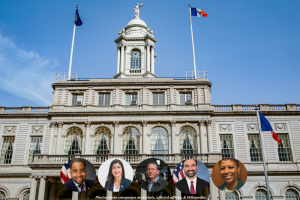By Brian Figeroux, Esq.
In 2025, New York City voters are once again preparing to cast their ballots using Ranked Choice Voting (RCV), a system that promises more choice, greater voter empowerment, and — for some — a little confusion. Whether you’re a seasoned participant or encountering RCV for the first time, understanding how it works and its impact on city elections is crucial.
How Ranked Choice Voting Works
In a Ranked Choice Voting election, voters can rank up to five candidates in order of preference instead of choosing just one. If a candidate receives more than 50% of first-choice votes, they win outright. If no one crosses that threshold, the candidate with the fewest first-choice votes is eliminated, and those votes are redistributed to voters’ next choices. This process continues in rounds until a candidate emerges with a majority.
For example, imagine a City Council race where no candidate secures 50% on the first count. The last-place finisher is eliminated, and their supporters’ second choices are counted. This continues until a winner is determined. The goal is to ensure the elected candidate reflects broader support among voters.
RCV in NYC So Far
New York City first used Ranked Choice Voting citywide in the 2021 primary and special elections. Initial results showed several trends: RCV did not drastically change overall voter turnout, but it did lead to more diverse winners, particularly among women and candidates of color.
Candidates generally ran more positive campaigns, often trying to become voters’ second or third choice if not their first. While some voters reported confusion, surveys found that a majority adapted quickly once they understood the system. Still, some races saw a high number of “exhausted” ballots — cases where a voter’s choices were eliminated before the final round, leaving their vote uncounted at the decisive moment.
Benefits and Criticisms
Supporters of RCV argue it promotes a healthier democratic process. By encouraging coalition-building and rewarding broader appeal, candidates are less incentivized to run purely negative campaigns. Voters have more freedom to choose their favorite candidates without worrying about “spoiling” the election. Additionally, RCV can lead to more representative outcomes, reflecting a wider range of voter preferences.
However, criticisms remain. Opponents argue that RCV can confuse voters, leading to errors or disengagement. The phenomenon of exhausted ballots raises concerns about whether every vote truly counts through to the final round. Some political observers worry that RCV benefits better-funded candidates who can afford broader voter education efforts.
Looking Ahead to 2025 and Beyond
As New Yorkers prepare for another round of elections under RCV, there is a strong push for expanded voter education to minimize confusion. City leaders are emphasizing outreach efforts, particularly in communities where ballot exhaustion was most common in past elections. As the system continues to evolve, voters’ familiarity and engagement will be key to making Ranked Choice Voting a lasting feature of New York City’s democratic process.
FAQ: Ranked Choice Voting in NYC (2025)
Q: What is Ranked Choice Voting (RCV)?
A: RCV lets you rank up to five candidates in order of preference instead of voting for just one.
Q: How does RCV work?
A:
- If a candidate gets more than 50% of first-choice votes, they win.
- If not, the last-place candidate is eliminated and their votes are reassigned to the next choice on those ballots.
- This process repeats until someone wins a majority.
Q: Where is RCV used in NYC?
A: RCV is used in primary and special elections for Mayor, City Council, Public Advocate, Comptroller, and Borough President. It’s not used for general elections.
Q: What happens if I only rank one candidate?
A: That’s fine! Your vote still counts. Ranking more candidates just gives you backup options if your first choice is eliminated.
Q: What if I rank the same candidate more than once?
A: It doesn’t help them. Your second, third, fourth, and fifth choices must be different candidates for your backup votes to matter.
Q: What’s an “exhausted” ballot?
A: A ballot is “exhausted” if all the candidates you ranked are eliminated before a winner is declared. Your vote won’t count in the final rounds if that happens.
Q: Why are people still debating RCV?
A: Supporters say it encourages positive campaigns and more diverse winners. Critics worry it can confuse voters and cause some votes not to count in the final round.
Q: Where can I learn more before voting?
A: NYC’s Board of Elections and many nonprofits offer free guides, practice ballots, and videos to help you get comfortable with RCV.
Ranked Choice Voting: Do’s and Don’ts for NYC Voters (2025)
✅ DO:
- Rank up to five candidates — You don’t have to rank five, but you can!
- Rank different candidates — Each rank should be a different person.
- Vote your true favorite first — Always put your top choice at #1.
- Use all your rankings if you want — It gives you more backup options.
- Get help if you’re confused — Poll workers are trained to assist!
❌ DON’T:
- Don’t rank the same candidate multiple times — It won’t give them extra points.
- Don’t skip rankings unless you really want to — Leaving blanks is allowed but might waste a chance to influence later rounds.
- Don’t worry about “spoiling” the race — RCV is designed to eliminate spoiler effects.
- Don’t panic if you make a mistake — Ask for a new ballot before you cast it.
Pro Tip:
The more candidates you rank, the more say you have in who wins — even if your top choice doesn’t make it!
Click Here to Schedule a Consultation with Figeroux & Associates Today!



